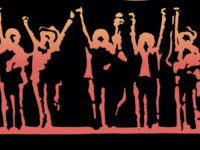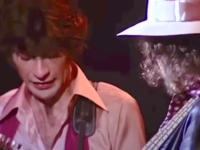Robbie Robertson, though he shares a Native American heritage, spent the first few months on this project simply listening to Indian songs. Then, before fully engaging for the first time in this legacy music, he tried to forget all of that and simply create.
The occasion was a score for a 1994 PBS series called The Native Americans, but Robertson clearly approached this with a fierce curiosity. The results, recorded with a shifting amalgam called the Red Road Ensemble and titled Music from ‘The Native Americans’, boldly meld Robertson’s life-long penchant toward old-world hagiography with a previously unheard musical complexity. It sounds, like the best of his work with the Band, ageless and utterly new.
Some, familiar only with his biggest previous successes, probably saw all of this as a strange left turn. But, in truth, Robertson — who is Mohawk from his mother’s side of the family — made overt references to a childhood partially spent at Canada’s Six Nations Indian Reservation as early as “Where Do We Go From Here” and, more particularly, “Smoke Signal” on 1971’s Cahoots.
“My job was to do music that would complement the series, emotionally and dramatically,” Robertson said at the time. “That gave me the opportunity to do something that’s been in my heart for a long time.”
<<< BACKWARD (“Mystery Train”) ||| ONWARD (“Blue River”) >>>
With “Ghost Dance,” a natural outgrowth of (and vast improvement on) those early attempts, Robertson reached a stunning vista — fashioning a heady mix of rootsy grooves and modern textures, made complete with a dramatic overlay of First Nations’ history and philosophy.
As with Band-era triumphs like “The Night They Drove Old Dixie Down” and “Acadian Driftwood,” Robertson’s song grew out of, and then expanded upon, something historical: A particularly gruesome moment on the Lakota Pine Ridge Indian Reservation in December of 1890 when hundreds of Native Americans were massacred near Wounded Knee Creek, and then unceremoniously buried in a mass grave, over a misunderstanding that resonated deeply with Robertson. He began with an image of the buffalo — which, like the Native American’s culture, was vanishing at a precipitous rate.
“I desperately wanted to express something about what Wounded Knee was about,” Robertson said. “Things were getting desperate for the Indian Nations. In 1800, there were 40 million buffalo. In 1850, there were 20 million buffalo. In 1900, there were 500. Destroying these animals for the skins was overwhelming to Indian people. Out of this came a prayer of desperation called the Ghost Dance.”
This religious expression had emerged from the teachings of Jack Wilson, a spiritual leader known as Wavoka who Robertson dubbed “a Paiute Messiah.” The prayer dance expressed hope for two things, Robertson said: “The return of the buffalo, and a better day to come in our lives. It spread across Indian nations like mad. Washington didn’t like the name of it, and told Indians it was against the law to do the Ghost Dance. It became apparent that freedom of religion didn’t apply to these people.”
But Robertson, and this is the wonder of “Ghost Dance,” doesn’t simply retell what happens next — as compelling as that may be. Instead, he focuses on the native people’s philosophical approach to this monstrosity — so very different than our own. They convey, through a stirring lyric here, a far-sighted belief system that gives them strength through an unthinkable situation.
“They refused to stop doing it,” Robertson adds. “The calvary attacked the Sioux nation, and massacred 300 — mostly women and children — at Wounded Knee in the Dakotas, and buried them in one big grave. It is such a horror to me. I needed to write a piece of music that expressed something of this event and feeling.”
- How Deep Cuts on ‘Music From Big Pink’ Underscore the Band’s Triumph - July 31, 2023
- How ‘Islands’ Signaled the Sad End of the Band’s Five-Man Edition - March 15, 2022
- The Band’s ‘Christmas Must Be Tonight’ Remains an Unjustly Overlooked Holiday Classic - December 25, 2016




